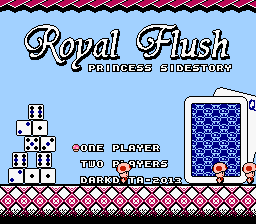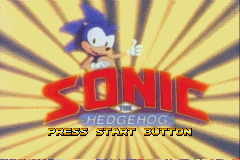Here at Gaming Reinvented, we’ve interviewed many notable figures from the internet’s ROM hacking communities. We’ve interviewed Kaze Emanuar about Super Mario 64 Last Impact and Super Mario Run 64. We’ve spoken to SKELUX about Super Mario Star Road and other such projects. And with everyone from REGNR8 to Levelengine and DahrkDaiz having done interviews with the site, we can safely say we’ve amassed quite the list of interviews with famous ROM hackers over the years.
But today, that list gets even still. Why? Because as the title of the article suggests, today’s interview is with Captain Southbird, the creator of a certain well known Super Mario Bros 3 mod called Super Mario Bros 3Mix.
Yeah, that Super Mario Bros 3Mix. The one that used a disassembly of the game by said creator to reimagine Super Mario Bros 3 into an all new adventure filled with worlds based on past games, custom graphics and music and all manner of custom bosses and level gimmicks from all throughout Mario’s history.
It’s an interesting project, and one that made us interested in hearing the story behind it straight from its author.
So, if you’re also interested in the game (or just want to hear what Southbird has to say about gaming as a whole), keep reading!
First things first Captain Southbird. Who are you?
A nerd who’s been on the Internet one way or another for about 20 years now. Gone through a bunch of forgotten names before settling on “Southbird” (or the full length “Captain Southbird”.) Out there in the “real world” I’m a senior software engineer in charge of an important industrial business application that no one short of specific mechanical engineers would have any interest in.
And where did your username come from anyway? Why Southbird?
A now ex-girlfriend was a passionate fan of the anime One Piece. I was never heavily into it, but I shared it with her at the time. In that series there was a creature known as a South Bird, which was a bird that attempted to always face south, which I personally found amusing. The ex started up a forum dedicated to One Piece and I registered under the name “Southbird.” After that it just sort of stuck, not really sure why.
The “Captain” part came from when I was registering for a Tumblr account (for promoting 3Mix’s development) and “Southbird” had already been taken. It suggested the prefix “Captain” which amused me, so I took it. In hindsight I’ve found a LOT of Internet usernames are prefixed “Captain” so now it just feels unoriginal, but I suppose I’d have an impossible time to divorce myself from it now!
What about your history with video games? What console did you start with originally?
Originally it was a long-forgotten console known as the “Bally Astrocade”, but I was very young and only have spotty memories about that. The first real console that I remember spending hours on was an Atari 7800. It was a huge part of my early childhood, which made me fiercely loyal, and it felt impossible to supersede that against this new-fangled NES that all the “cool kids” at school were playing. Eventually my older sister obtained an NES, which came with Super Mario Bros 3., and about 30 seconds of first seeing it – with scrolling screens and music playing – I instantly knew my loyalty was misplaced and a whole new world was opened to me.
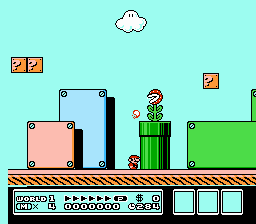
This explains both my passion for SMB3 and also was the beginning of my interest in computer science (I needed to understand how video games worked all of a sudden!) that led into my current professional career.
How about now? Are there any recent video games you’ve enjoyed, like on the Switch/PC/PS4/Xbox One?
Despite being very involved in the NES, SNES, Sega Genesis era of games, I really dropped off the radar around when the original PlayStation landed, as I became more fascinated with making them than playing them. I didn’t own another video game console until the Gameboy Advance (which I only used for developing on) and then a Wii, which was mostly only for Mario titles.
These days video games I actually play are pretty niche and usually with ulterior motives. I was into Minecraft for a while because there was a server being run by co-workers and it was kind of fun to share progress made in the world (as opposed to doing actual work.) It’s also been a nice way to connect with my older sister who presently lives in another state. I’ve also played Terraria as a friend of mine is particularly into it, which I’ve enjoyed. But ultimately, I think I still love video games more for the guts and the fascination of how they can express an interactive fantasy, and my interest still is more with being able to create such an experience by my own hand than play many of them.
Did you want to make your own games as a kid?
Absolutely, and I tried many times. Usually it was just inexperience and flighty interests that ended them pretty early. There’s a few of these attempts that survived time in old backup files, nothing worth mentioning really, except for a now ~17-year-old Sonic fangame known as Sonic Epoch. (Which I’m still surprised the Internet somehow has never truly forgotten.)
Hell, did any of those ideas influence your ROM hacks and mods?
Constant experimentation definitely helped me learn the basics. Like how early platformers (and some still today) used “grids” of tiles to define the world geometry, or “bounding boxes” to detect between sprite objects. A lot of this basic stuff was used by the amateurs and professionals alike through the 80-90s and onward, so it definitely helped to have a core understanding of these concepts when trying to reverse engineer the games.
More to the point, before there was even a computer in the family household, I was already drawing new levels for SMB3 on paper, which miraculously somehow mostly survived all these years. I was able to use some of it in 3Mix which was very special.
Still, enough general background stuff for now. How did you get into ROM hacking anyway?
I’ve always been fascinated with game consoles and their generally proprietary architectures. Then the homebrew world opened up the Gameboy Advance. Complete with tools and great documentation, it was a relatively easy platform to get into. Of course, this was all my own code written in C, not quite useful yet for ROM hacking. As I worked on the GBA, I ended up writing a sound mixer in pure ARM7 assembler, which was really the gateway to beginning to understand computer architecture.
Meanwhile, folks over in the Sonic world were reverse engineering Sonic the Hedgehog 2 (primarily) and opening up a publicly available disassembly of the game code. This was also making it possible to really appreciate every nook and cranny to find any possible “lost” materials and gain understanding fundamentally of how the game worked! I felt compelled after this to give Super Mario Bros. 3 the same treatment, also hoping to find some kind of secrets within.
What about Super Mario Bros 3 ROM hacking? After all, most major Mario games have ROM hacking scenes now…
There definitely wasn’t anything like what I created for SMB3 at the time. Sure, there was some published information that roughly explained what some parts of the game did, an odd level editor here and there, but nothing that totally ripped the game apart from top to bottom and tried to explain every opcode.
Did any other mods of the game inspire you here?
Mario Adventure by DahrkDaiz, absolutely. DahrkDaiz didn’t have a disassembly but still managed to code an amazing amount of custom stuff. I played through all of Mario Adventure at some earlier point just simply fascinated by all the ways the game had been changed. I figured that Mario Adventure set the bar and naturally it was only right to try to top it. I suppose whether or not 3Mix truly did that is up for debate, but I certainly gave it my all!
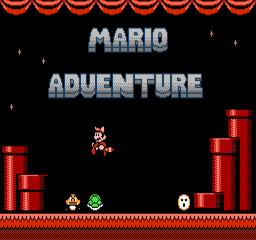
Either way, 3Mix is based on the Southbird disassembly you made beforehand. What was it like reverse engineering Super Mario Bros 3? What challenges did you encounter along the way?
I went into the disassembly pretty blind. I knew very little about the NES architecture other than some real basics. I used a stock 6502 disassembler to do the initial disassembly pass, which of course was an awful mess. (There were much better ways to go about this, but I just didn’t know at the time.) The only thing I knew is that all NES software starts at a common execution address, so I started there and just began decoding it meticulously, one instruction at a time.
There would be periods where I’d have huge amounts of code and RAM addresses decoded but had no idea what they did, and I hoped as I progressed they’d become clear later. And generally, this was the case… I would be slogging through code, and then suddenly get an idea what part of the game I was actually in, and then suddenly so much of it would become clear relatively quickly.
Still, in the end, this took about two years (off and on) to complete. Lessons learned, I was able to use better tools and a handwritten NES-tuned disassembler to create at least buildable disassemblies of a handful of other games relatively quickly. These disassemblies are nowhere near the depth of SMB3, but still being able to get from absolutely nothing to buildable source within weeks is a lot better.
And how did you overcome many that stopped Nintendo themselves? After all, Miyamoto thought Yoshi wouldn’t be possible in a NES Mario game, but you got him working…
![]()
Many are aware of this famous anecdote, but I think what he meant has often been misunderstood. There’s nothing technically infeasible about Yoshi on an NES (obviously!), but what is worth noting is how intrusive Yoshi is in this model. Specifically, SMB3 uses a “memory mapper” known as an “MMC3”; without getting too technical, these “memory mappers” expanded the NES’s basic limitations by allowing more code and graphics to be loaded.
In terms of SMB3, the MMC3 allowed it to split the “background” graphics “in half” and switch those out dynamically. This enabled in-level animations. On the “sprite” side, it split the available graphics area into quarters. (This was the maximum granularity the device offered.) Just looking at the sprite side, an entire “quarter” would be dedicated to player graphics (changing frequently to support different animations) and another quarter was dedicated to static graphics, e.g. pop-up score banners, power-ups, and other things that needed to always be available. So, by this point, half the sprite graphics are already used up, and now you need your in-level enemies. As you can imagine, Yoshi would only compound the problem, and likely require another quarter all to himself. (Which, in 3Mix’s case, he did.)
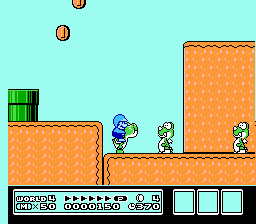
So, to be fair, Super Mario World allowed mostly free travel with Yoshi. You could take him almost anywhere. Without a major redesign (and constricted graphics), this just couldn’t happen in SMB3. Hence why in 3Mix Yoshi only makes limited appearances in select levels, i.e. levels that I planned out in advance to leave that “quarter” open for Yoshi to occupy.
Now, there were better “memory mappers” that came after SMB3 which allowed finer granularity and other improved features, so I believe it is still possible to have a free reign Yoshi in a derivative SMB3 with enough planning. Just understand that when SMB3 was actually being created, such a thing likely was simply not feasible without hurting other areas of the game.
What was the most challenging thing to program for 3Mix and why?
The reverse gravity gimmick, absolutely. It was actually one of the first things I started coding before even knowing what I’d used it for. It required adding all kinds of “vertically reversed” logic in just about all areas of the game. It also revealed gaps such as there not being complete “upside down” data for ceiling slope tile data available to enemies (as they generally never needed to touch the ceilings… even the “ceiling walker” enemies were actually just hardcoded to follow a line.)
Playing Mario Galaxy and being fascinated with the gravity dynamics of course made it very clear how exactly it could be employed. While certainly not an identical experience in 3Mix, it still added a nice reminiscent feeling.
Onto the game’s design now though. How did you go about designing the levels for 3Mix?
3Mix didn’t exactly start with a solid idea. I sort of loosely wanted to integrate ideas from newer Mario games backwards into SMB3, like the Star Coins, which I always enjoyed hunting down in NSMB. Eventually as it started gaining traction, I thought it would be neat to make it sort of the “uber Mario game”, where I would keep backporting things just to see what they’d be like outside of their respective generation.
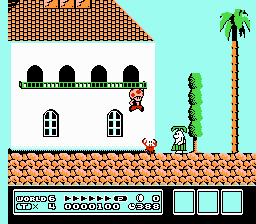
Once I started the pattern of “one world to a game / common theme” it really started coming together. Some of it was pretty obvious cloning (especially World 1), but it tended to get more inspired in later worlds, especially when trying to adopt concepts from 3D titles like Sunshine or Galaxy.
How about choosing the world themes? After all, 3Mix takes inspiration from quite a few previous Mario games, and always offers something new in every one…
It usually came down to a mix of something that made me nostalgic coupled with how technically feasible it would be. Obviously, some games like the Mario Kart series wouldn’t get represented reasonably. And it would be a monumental task to try to duplicate something like Fludd. What definitely made it interesting however was that pretty much every world mandated a new programming challenge. Like World 1’s Bowser bridge, or World 2’s pick up / throw mechanic, etc. Some games were easier to make a world out of than others (obviously 2D titles offered plenty of adoption) but other games (like Sunshine) were less trivial to implement partly because there wasn’t always a lot that directly translated.
Were there any ideas you wanted that didn’t work out here?
I wanted to do more with the bonus games, as they wound up being one of the more fascinating and largely incomplete areas of SMB3. I was thinking it would be great to employ the “lost” bonus game hosts, the Koopa Troopa and Hammer Bro, particularly in a Dark World setting or something. Ultimately though they were stuck in World Zero as key guardians.
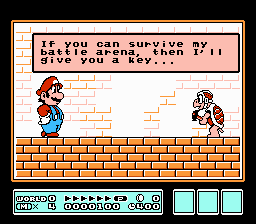
Probably the greatest one that sticks out in my mind was an attempt to do the “shifting maze” that shows up in a few Super Mario World levels. Where the (typically yellow) ground is shifting up and down against the (typically brown) static ground, in some cases risking you getting crushed to death. As it turns out though, given the restrictions of the NES, this effect pretty much can’t be pulled off, at least not satisfactorily. There’s actually a “lost” level segment leftover from when I gave it my best shot but was so disappointed with it I just abandoned it.
Conversely, any you’re particularly proud of here? Which level or world in 3Mix would you say is your best and why?
For all the trouble, World 7 levels when I got to use the gravity gimmick are probably my favourite. Like in 7-1, when the player is just thrust into the thick of it, with rough approximations of Galaxy-esque planetoids. I’m really happy for the most part people were able to figure it out and play these levels. I think, given all limitations, it’s a nice approximation of the Galaxy feel, and truly unlike anything stock SMB3 had to offer.
Another thing the game gets a lot of credit for are the bosses, all of which are very different to the original Mario 3 ones. So how did you design them? How did you choose which previous Mario game foes should return in 3Mix?

I’ve mentioned my paper drawings earlier, and in those I had actually sketched the Koopalings in various “mech” type suits or other crazy contraptions. I did sort of want to do something like that in 3Mix, but “large” bosses require a lot of technical investment on the NES.
Going with Bowser Jr. as a gimmick instead (which I know to some old fans is basically a sin) seemed to work better, as if he was somehow trying to orchestrate these attacks (true to his character.) Most of them are imports or adaptions of bosses from other games so I can’t take too much credit there. Any of the ones that are unique are pretty much just me trying to think of a cross between the world theme and something Bowser Jr would do, like the large Boo equipped with cannons, known as Boomer.
And how did you redesign them to work with Mario 3’s engine anyway? Because the bosses have a few interesting attack pattern differences here…
Some parts of SMB3 I simply tried to reuse, other times I was inventing my own patterns. In any case, once the source code is open to you, you’re not necessarily confined to what the original developers had to go through. I also had the benefit that jumping from 256KB of program space to 512KB program space is absolutely trivial now, though back then it would have been prohibitively expensive. Basically, I had “more room to play”, and I could just kind of code things however I wanted.
This wasn’t always for the best as some of my less efficient code wound up causing new lag that wasn’t part of stock SMB3 (not that it was without lag itself, of course.) Reznor is a particularly awful example of induced lag. But Reznor also pushed the engine to its limit because of the sheer number of sprites required to make it work.
Either way, one of the most interesting battles is in the final one, with a certain foe right from Super Paper Mario. So how does that all tie into 3Mix’s story?
Honestly… it probably doesn’t! At least, not the main theme. World Zero is more a tribute to video game malfunction, a world where up is down and none of it quite feels right. You figure said villain kind of lived in a miserable monochromatic world that devoured others, so perhaps World Zero is in fact a partially consumed / corrupted world.
Heck, what is 3Mix’s story anyway?
Like most Mario games, it’s not really a heavy storyline. The Princess is kidnapped, and Mario chases her through worlds. It’s just more of a modernized version of classic Mario games with concepts like Bowser Jr. and more diverse settings. Maybe it’s more of a “clip show” episode than a series arc.
Regardless, 3Mix absolutely blew up when it was released, becoming one of the most well-known Super Mario Bros 3 hacks in history. Did you expect it to be received so well?
Not at all. I mean, I figured it’d do okay, and I was hoping a few folks would enjoy it. It was really a passion project. I just wanted to not only claim I had disassembled SMB3, but also demo something that showed what could be done with it. I keep hoping one day someone will release something truly amazing based on its source.
How did it feel seeing the media cover your game? Or to see Mike Matei cover it at Cinemassacre?

This was a huge moment for me. Although, of course, a huge bummer as well, as he found a game-breaking bug that was enshrined in a video with several hundred thousand views and a disappointing end to that video. It did inspire me to quickly release a patch correcting it, and I now always refer to it as “the Matei Bug.”
However, some good came of it I suppose, which got me involved in my current side work as a highlight video editor for the streamer Vinny of the Vinesauce group. Vinny streamed 3Mix at one point which got him and I talking. But that’s a story for another article I suppose.

Do you feel it may have influenced quite a few more hacks too? Cause it seems like since it seems like it and Mario Adventure 3 might be bringing in a more ambitious era of SMB 3 hacking…
From what I understand, somewhat amusingly, is that DahrkDaiz said something once like they’d never do another huge project unless a disassembly for SMB3 was released, never knowing that in fact one day that would actually happen. I don’t know a lot of the details about what DahrkDaiz is up to exactly, but I believe the aforementioned “memory mapper” has been “upgraded” to a later generation one, and that alone will probably open up the codebase to huge new possibilities.
I’m not connected with the hacking communities out there to really know who else is using the disassembly. The only other project I remember seeing was one called “Royal Flush – Princess Sidestory”, which I also don’t know if that ever progressed beyond some videos I saw of it a few years ago. I may have inspired some folks, but I really have no idea who else may have been influenced or helped from my work.
Lastly on the mod front, what future plans do you have here? Are you interested in making a sequel to 3Mix down the line?
3Mix itself was kind of purely fuelled by childhood nostalgia and I think it just nearly perfectly represents exactly what I wanted to get across. I can’t really imagine a “sequel” to it, per se. I mean, it’d probably not land as well to do another “let’s stuff all the Mario games in there” project again.
Whether or not I’d want to make something else out of the SMB3 engine has come up a few times, and I tried an idea here or there, but they generally fizzled. Not sure I really have enough inspiration to do anything else with it.
Onto a few other projects you worked on now. What was the thought process behind Sonic Epoch?
Well… first we need to time travel back to the 90s and remember what “Sonic the Hedgehog” was during that decade! Sega had pretty much made themselves a formidable opponent mascot against Nintendo’s stalwart Mario, worthy of school playground arguments that I was frequently in and around.
I loved all the Genesis-era Sonic games. They were ones I played again and again, for many hours of my youth. So obviously when a cartoon adaption was announced, I was psyched. The one I would actually be exposed to was Adventures of Sonic the Hedgehog… the slapstick zany one. As far as I knew, that was the only Sonic cartoon out there. It actually wouldn’t be until my first foray onto the very young Internet (over a slow dial-up connection) that I would learn of the (then only) other… the one they called “SatAM.”
Given this early age before everyone could basically know everything in an hour, this was a surreal experience. Completely contrasting the zany slapstick were these (low resolution and grainy) screenshots depicting a dark looking Sonic world, one that clearly was taking itself far more seriously than Adventures had ever dared. Something I had never knew existed had been there all along. Of course, sadly, I find this out just after it had been taken off the air completely.
I scrounged video stores looking for VHS tapes (yes, I’m old), desperately trying to locate any copies of this cartoon. (We didn’t have YouTube or other great distribution sites yet, kids. Nor the bandwidth to support them.) I manage to find only one, just two episodes … compared to my experience with Adventures, this was an extraordinary experience. The bright colourful fantasy worlds replaced with cruel dictatorship. A real sense of battle between the underdog good and the impossible evil, nature vs. man, the whole bit. And, perhaps most sinister of all, the episodes didn’t always exactly end happily with a bow wrapping up all the problems.
Needless to say, I was hooked, and when the Internet was finally able to barely provide really low quality compressed episodes, I was finally able to experience this in full. And this really defined what Sonic Epoch would be.
All of this should definitely clue you in that my overt fascination with the concept made me want to extend and celebrate it. Especially given its premature demise that its lingering fans mourned loudly about at the time. I wanted to make something that truly honoured the concept faithfully and brought about a whole new story.
Of course, it fell short in a LOT of areas, but I was also only 17-18 at the time. I also never finished the original version because I broke up with my girlfriend at the time and, of course, to a teenager, that just means LIFE IS OVER. Ah, how absolute life seems when you’re young.
The fact that the Internet has not yet forgotten about it tells me that it really did touch a lot of folks, though. And that causes a part of me to want to reboot it, try harder to get it right, and, most importantly, complete it as it was intended! I don’t know if that’ll ever happen, but it’s still a deep desire of mine if I can find the time and inspiration. Even though it’d be for an over-20-years-off-the-air cartoon that ran for just two seasons.
And what was it like working on that anyway? Seems kind of strange to see a fan game ported from the PC to the GBA… Heck, how did you get it running on the GBA anyway? It’s impressive for a homebrew title.
To put things in perspective, the GBA, especially with areas it accelerates in hardware, really wasn’t all that much less powerful than the PCs I was developing for during Epoch’s heyday. I actually was testing regularly on a sub-100MHz computer because it wasn’t impossible some folks were still using those. 🙂
Porting it to the GBA was more of just shtick; I had figured out how to code on it somewhat reasonably and putting Epoch on there was just because I could. Bonus points that I could see it running on a proprietary game console. While I think I had gotten some parts of it better, unfortunately it wasn’t a substantial improvement in terms of gameplay. It still had terrible controls and visibility problems, along with story dialog that varied in quality.
My biggest regret was, once again, it’s not really finished like it was supposed to be. This time I found some nitpicky corner of the Internet making fun of the project. (Not of its merits, just conceptually.) I became self-conscious and unable to put passion into it like I had before. I was maybe halfway done and, unwilling to simply let it be unfinished like its predecessor, I rushed it and pushed it out very quickly. The story is left completely awkwardly and incorrectly handled and there are game breaking bugs especially in the later levels, which are also often very empty or boring.
Being able to handle criticism is a hard life lesson. Even harder to deal with those who simply could never possibly like what you’re creating no matter what you do. Putting yourself out there inherently means a risk of people trying to tear you down. Fortunately, I’ve had a lot of experience dealing with that these last few years, too bad it came too late for Epoch.
Still, it may not have aged too well compared to your other projects. Do you ever plan to revisit it, like your site suggests?
It absolutely does not age well. It pains me that it’s the only “complete” version out there.
Incidentally, over the years I have attempted to resuscitate it numerous times in various forms. One was an attempt at simply enhancing the PC version, another was a dramatic re-envisioning using graphics based on the now-available DVDs. None have yet succeeded though…
However, in 2014, I undertook the task to at least write the story out and get it vetted by an old friend of mine from back when I was involved with the Sonic fans. I’m pretty certain I at least have that figured out with a much better perspective. And no, Tails does not drop F-bombs every other word in it either. 🙂
Nearly done now! You also seem to host sites about Centralia PA and a SMB 1 hack called Super Sponge Bros too. So… what was the history here? How did you get interested in the situation in Centralia, or end up hosting this SMB 1 mod?
Centralia, PA is just a tragic story close to home. It’s a small town that thrived briefly on a now defunct mining industry. A fire was accidentally set that caused underground coal seams to burn, very slowly. This resulted in homes being filled with carbon monoxide and the heat caused a major highway nearby to buckle. There would be visible smoke plumes emerging from cracks in the ground, and supposedly even orange glowing lights visible at night.
Being they were a small town not really worth much, they didn’t have the assets to fix the problem, and begging the government for help led to red tape and, each time they got a pittance, it would have been months and the fire only got larger, and they didn’t have enough. This cycle repeated a few times until basically it became less expensive to buy everyone’s homes and kick them out than to solve the problem.
There have been other towns in the US and around the world that had some kind of collapse story like that, so it’s not wholly unique… it’s just close enough to me that I had a temporary fascination with their plight. But really by this point there’s hardly anything left and anyone who was fighting for it has either died or moved on, so, there’s not much left to say.

Super Sponge Bros. on the other hand is a far less interesting story… basically it’s a fan tribute to an in-joke / community creation of Vinesauce Vinny’s streaming world. For whatever reason, the creator did not want to be known for it, so they released it anonymously. They asked me specifically, as I’m Vinny’s highlight video editor, to host it, and not reveal who they were. That’s really there is to that.
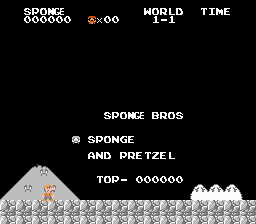
Are there any other interests you have plans to create websites about?
Not at this time. I’m mostly in the media world of YouTube and the rest of my fleeting interests show up on Twitter.
Finally, what advice would you give anyone else wanting to get started in fan game or ROM hack development and why?
As far as ROM hacks go, most importantly, know that it’s tedious and difficult. These games weren’t designed for custom content. The developer’s secrets are tied up in obfuscated code. If you want to make a really deep hack, prepare yourself to learn the architecture you’re targeting. Hopefully you have an emulator with a good debugger!
For really either ROM hacks or fangames, making a “3Mix” is not for everyone. With any project you get involved in, consider the scale of it, especially against how much time you can reasonably invest. It’s easy to imagine grandiose ideas but realizing them is a whole other deal. Most importantly, fangames and ROM hacks are usually unpaid activities. Most follow the unsustainable pattern of hyping up an idea, getting a bunch of people on board, and everyone quickly disappears because life happens. Consider perhaps a more reduced scale and manageable version of your original idea.
That’s not to dissuade anyone from dreaming big, of course… just be aware of what you’re getting into, and, statistically, the likelihood that your complex, unpaid activity, at the end of the day, will probably rely on you, and just you, to finish it.
And you know what?
That’s a point we agree with 100% of the way. ROM hacking and fan game development are not for everyone, and the work involved to make something truly incredible can indeed be more than many people can cope with. After all, go to any fan game website. Note how few hacks and games get past the first demo (or even a few screenshots/videos in a topic) before being cancelled.
It’s a tough process, and the level of effort needed to go even further and create something as insane as Super Mario Bros 3Mix, Super Mario 64 Last Impact or Newer Super Mario Bros Wii is just immense, to the point it’s almost like having a second full-time job on top of your primary one.
But don’t let that dissuade you! Follow your dreams, try making a fan game or mod if that interests you and remember:
Rome wasn’t built in a day. This is something that takes a lot of time and effort, and will involve years of unpaid work to complete to its fullest.
For your ROM hackers and modders out there, good luck. For the rest of you? Well we hope you enjoyed the interview, and we’ll see you soon with more great interviews over here on Gaming Reinvented!
